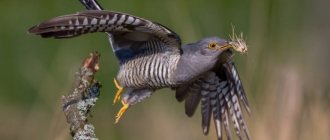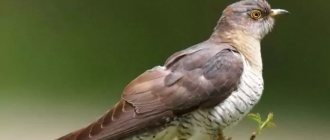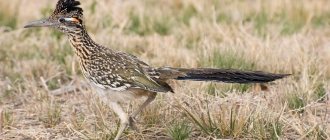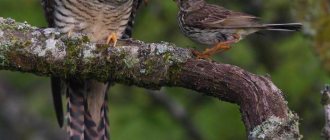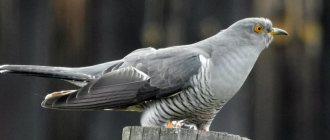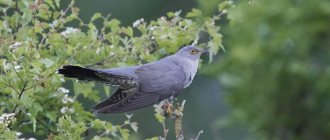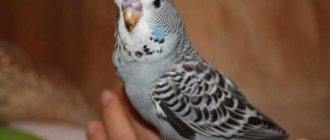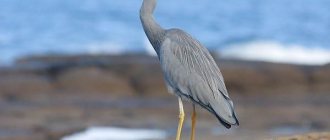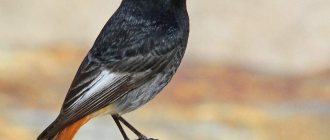In Ancient Rus', the cuckoo was considered the most mysterious bird, and even now all of us, having heard its cuckooing somewhere in the bosom of nature, with bated breath, begin to count after it - how many more years do we have to live? And although everyone understands perfectly well that all this makes no sense, we, like our ancestors many centuries ago, continue this count.
Few people know that from ancient times the cuckoo was credited with not only knowledge of the duration of the human life cycle. Superstitions are also associated with it, thanks to which people made forecasts about the weather, the upcoming harvest, and their future fate. What could they do? There were no forecasters with their weather forecasts then. I just had to trust the cuckoo.
Sign about the first cuckoo
- Previously, people believed that the cuckoo was a bird of paradise, which was the first to migrate south in the fall, and the last to fly back in the spring. Her cuckooing was associated with numerous signs, even fateful ones, and many of them were negative. It was believed that the cuckoo was the gatekeeper of the other world, a harbinger of unfortunate events.
- The ancestors listened to the shades of sounds that this, in their opinion, mystical bird made, looked closely at where it was located - all this together allowed them to unravel future events.
- People also associated the cuckoo's cuckooing with the place in which the person who heard it for the first time in the spring was and what he was doing.
Presage changes in the weather and the arrival of spring
Conducting experiments with other people's eggs
Once, during a summer internship at a biological station, we performed such an interesting experiment.
“Let’s see how different small birds will behave when we place different alien eggs in their nests,” I suggested to the students. “After all, this will allow us to understand the significance of the different colors of cuckoo eggs.”
Numerous sparrows nested in birdhouses hung on the trees of the park and under the roofs of station buildings. Since spring, occupying all the corners convenient for making nests, they have prevented the colonization of the estate by useful birds.
We tried to reduce the number of uninvited settlers by all possible means. We decided to use the clutches of both types of sparrows, that is, house and field sparrows, for our purposes. To everyone's delight, the sparrow eggs taken from the nests varied greatly in size and color;
- some of them were large and light,
- others are small and dark.
The first nest, which served for our experiments, belonged to a small bird - a stonechat. The stonechat's nest was located under a clover bush at the edge of the meadow, containing six small bright blue eggs. The bird has already finished laying and has begun incubation.
I know that birds can count. True, they do this differently than people, but they are able to accurately determine that their nest is missing or has an extra egg.
By the time of incubation, feathers fall out on the ventral side of the bird and so-called brood spots are formed; Each egg in the clutch comes into contact with the bare skin of the bird sitting on the nest. Take out at least one of the eggs or add an extra one, and the bird will immediately detect a change that has taken place in the nest.
To prevent this from happening, we carefully removed one small blue egg from the stonechat's nest and replaced it with a light gray large house sparrow egg. The difference in the size and color of the eggs was striking, and it would seem that the bird should have noticed it immediately, but the stonechat did not pay any attention to the differences in the eggs and sat down to incubate again.
Shrikes behaved in the same way. Two of them did not pay attention to the appearance of sparrow eggs in their nests, but the third exceeded all expectations and diligently incubated the clutch, among the eggs of which a bright red dragee appeared, which, moreover, did not have an egg shape. After these experiments, the poor birds seemed primitive to us.
How easy it is for a cuckoo to place eggs of any color in the nests of such simpletons! This is essentially what happens in nature in many cases.
The bird does not notice when a cuckoo egg appears in its nest, the cuckoo hatches and conscientiously feeds the noisy, insatiable glutton. But things are not always that simple. However, let me return to our experiments.
The sad fate of the lining
Above the river, in the thick nettles, we soon managed to find the nest of our excellent songbird - the marsh warbler. This bird is an active, big-eyed and cheerful marsh warbler. Five small eggs, decorated with gray spots on a pale blue background, lay in a deep, skillfully woven nest.
The light structure of the bird was fixed on three dry stalks of grass and seemed to hang in the air. It is not easy for a cat to reach such a nest, and even for a feathered predator it is not easy to find it.
After flushing the bird from the nest, we replaced one of the warbler eggs with a larger house sparrow egg. From a nearby bush, we began to observe the behavior of the warbler from afar.
The smart bird immediately drew attention to the laid egg, restlessly fluttered from branch to branch for about two minutes, then sat down in the nest and, anointing itself in it, pushed the egg to the wall, and then quietly threw it out.
We hastened to replace the broken lining with a new one. But this time too, a big-eyed warbler immediately distinguished him and threw him to the ground. Five times we placed new eggs in the nest, and they immediately suffered the same sad fate.
And now the warbler’s excitement reached its limit. The last time she managed to throw onto the ground not only the sparrow's egg, but also two of her own eggs.
We stopped the experiments, fearing that her nest would completely die. The warbler sat on the eggs, but for a long time could not calm down. She probably felt through her brood spot that not all her eggs were in place.
Trouble for small birds
Some small birds are highly gifted and are able to distinguish other people's eggs placed in their nests by color. But thousands of years passed, and some of the cuckoos began to lay eggs that were surprisingly similar to the eggs of warblers and other birds.
Nowadays, most warblers, like other birds, hatch and feed cuckoo chicks.
Cuckoos cause a lot of trouble and trouble to our small birds. And yet they are certainly useful for agriculture and deserve human protection.
The cuckoo crows: good omens
- If the first cuckoo crows while a person is doing some specific work, then he will have to do this work throughout the year. If he, for example, worked in a garden or vegetable garden, then he will have to spend a lot of time at the dacha. And those who were on vacation just then will expect peace and tranquility this year.
- If the person who heard the first cuckoo is strong and healthy, then his health will not fail him throughout the year.
Singing can attract health and money
- When you hear the cuckoo crow for the first time of the year, quickly make a wish for what you most want to get from life. If the soothsayer crowed to your right, then your wish will come true. To consolidate the result, you need to throw a coin from your right hand to your left . So, just in case, keep some change in your pocket in early spring - in case you happen to hear the “correct” first cuckoo on that very day.
- The cuckoo has a special attitude towards money. Ring some change in your pocket or wallet at the time when the first cuckoo sings, and all your financial problems will be solved, and you will not lack money - until the cuckoo returns again from warm countries.
- There is even such a sign about the cuckoo: if at the moment the first cuckoo crows your wallet is tightly stuffed with money, then your finances will increase significantly.
- If a cuckoo crows from the east, west (side) of a person, then this promises him prosperity. If the cuckooing comes from somewhere in front, then this is news of his long life journey in good health.
- It is believed that babies whose birth was accompanied by the first cuckoo cry will be happy - such children will be lucky throughout their lives.
- If green grass or soft earth served as a “carpet” for the person who heard the first cuckoo, then he will be lucky.
- Having heard the first cuckoo, you need to quickly lie down on the grass - and then you can forget about your troubles for a whole year.
As protection from troubles
- If a cuckoo arrives from warm countries ahead of time and begins to crow, then such a year will be unlucky for thieves. This interpretation had a rational basis, since the early cuckoo foretells a crop failure, then the attackers will have nothing to steal.
Characteristic signs
A total of 4 subspecies are known, the differences between which are almost invisible. It is worth noting the strong similarity between the appearance of the cuckoo and the sparrowhawk: the shape of the head, the hook-like tip of the nose, part of the plumage, flight behavior - all this helps the cuckoos in the struggle for survival.
The size of the bird is closer to that of a pigeon, with a weight of 100 to 180 g, the body length can be 33 cm. But the wingspan is impressive - about 65 cm. In combination with a long wedge-shaped tail, they provide the cuckoo with good maneuverability among trees and bushes.
The paws deserve special attention - they are strong and short, have the same structure (zygodactyl) as the paws of parrots or woodpeckers: two toes point both forward and backward. This allows the bird to easily and comfortably stay on branches, but creates problems with moving along horizontal planes.
The hard dark gray plumage was inherited by nature from the male cuckoos, while the females received a reddish craw and throat. Both sexes have a white chest and white belly, on which transverse stripes are clearly visible, as well as yellow thick trousers on the legs. Some females have a brown coating on the top of the back and wings, with dark spots. Eyes can be yellow or orange.
From cold weather to spring warmth, the cuckoo is difficult to detect; it is quite secretive and silent, and from cool regions it even migrates to warm regions. But from spring to mid-summer, the shouting in the area does not stop: “ku-ku, ku-ku”, emphasizing the first syllable, the males call the females, who respond with a ringing trill of “kli-kli-kli”, sometimes it even resembles a gurgle. In the silence, the echoes of cuckooing can be heard even two kilometers away.
The cuckoo crows: negative signs
- If this gray bird “paid a visit” to the village, then for the peasants it was a bad sign - they believed that the cuckoo brought all sorts of misfortunes to their village.
- The cuckoo sat on a tree near the house and screamed to the dead man.
- Previously, it was believed that if this prophetic bird flies low over a person, crows from the north side, or sits on a withered tree, then all this will lead to death.
- The first cuckoo has crowed - don’t lower your eyes, because something bad might happen.
- God forbid, a feathered soothsayer crows on autumn days - this is not good. If Peter's Day has already passed, then trouble may happen to those who hear the cuckoo. In this case, you need to shout “cuckoo” back to her - this will make the bird fall silent, and the omen will not work.
- If this little gray bird sat on the fence of the cattle pen, the peasants feared the onset of pestilence.
- People did not expect anything good from the cuckoo, which chose the roof of the house for itself and started its song there.
- The cuckoo darted around the entire village, as if unable to find a place for itself - there would be a fire .
- The cuckoo on the left will sing - to misfortune and numerous life mistakes.
- A bird singing behind a person promised health problems People anxiously awaited the arrival of illness if they heard the cuckoo's song while lying in bed.
- Lent has come, and the cuckoo suddenly starts singing at this time - this is not a good sign.
- The bird crowed, and the wallet is empty at this time - to hunger and poverty.
- If the cuckoo outstrips the nightingale with its singing in the spring, this year the people who hear it will face sadness and boredom.
- In the old days, girls listened carefully to the cuckooing of the winged soothsayer: how many times the cuckoo says its “cuckoo”, that’s how many years it will have to cuckoo as girls.
Other people's nests for breeding their offspring
Scientists around the world know that our cuckoos do not incubate their own eggs. Each cuckoo is capable of laying a lot of eggs during the spring-summer period, and the intervals between individual clutches are too long to successfully hatch offspring from such an extended clutch.
The first egg laid in the clutch will have time to dry out and deteriorate before she lays the last one. The responsibility for hatching, feeding and raising the cuckoo falls on the unlucky bird in whose nest the cuckoo is lucky enough to lay an egg.
The hatched cuckoo has an amazing appetite. He is able to eat for whole days, and a couple of small birds, that is, foster parents, have to spend a lot of time and effort to feed the gluttonous cuckoo.
Perhaps this is why the cuckoo does not tolerate other chicks near it and strives to throw them out of the nest.
Cuckoo eggs are small in size compared to the bird itself. They are much smaller than the eggs of the starling, oriole and slightly larger than the eggs of the finch or common bunting, that is, small birds compared to the cuckoo.
Of course, this has a certain significance in order to preserve an egg placed in someone else's nest. However, the most interesting thing about cuckoo eggs is their variety of colors. Take starling eggs for example: they are always pure blue.
Oriole eggs are white with black spots. The spots on finch eggs have rusty edges. Finally, there are birds whose eggs are of two or even four types of color. For example, the eggs of our little bird, the tree pipit. But in terms of the variety of eggs, the cuckoo is unrivaled. Our cuckoo eggs come in all sorts of colors!
Pure blue and coated:
- then large and rare,
- then in small and frequent spots
- or painted with complex curls, strokes and threads.
- In some cases, at first glance they differ from the eggs of the owner of the nest,
- in others, they are indistinguishable in color from eggs of another clutch.
I remember when I was a child, I loved to run to the small steppe pond. Along its edges reeds grew thickly, well protecting many pairs of small birds - blackbird warblers. On the stems of the reeds, above the water, they built their skillful hanging nests.
In the spring, loud bird songs and frog concerts could be heard from a distance from the pond. I often saw cuckoos in the reeds of the pond. I had a hunch that they did not fly here by chance, but in order to lay eggs in other people’s nests.
I wanted, at all costs, to find and see the cuckoo eggs with my own eyes. But I was haunted by failure.
Over the course of three springs, I carefully examined all the residential buildings of the warblers, but I never found cuckoo eggs in them. Imagine my disappointment and annoyance when I found a cuckoo in almost every nest I examined in July!
As it turned out, the cuckoos of this area laid eggs in size, shape and color surprisingly similar to the eggs of the blackbird warbler. This incident told me that not all small birds are such stupid simpletons and not all do not notice other people's eggs placed in their nests by the cuckoo.
When the cuckoo crows: folk signs about the weather
- May, the beginning of the first month of summer and late autumn become the stage for the feathered warbler-cuckoo? This is for warm weather. Spring has come, but the cuckoo crows long and often? This means that frosts are not expected this year.
A harbinger of cooling and warming
- Several cuckoos started singing at once - the day promises to be hot.
- Previously, people noticed that if July has already passed the 13th month, and the cuckoo continues to sing, it means that the rest of the summer will be warm and dry.
- If she suddenly starts singing on autumn days, then the Indian summer will be dry and long.
- The cuckoo crows loudly - precipitation will fall soon. And if she takes a liking to a dry tree and begins to crow there, this means early frosts.
- The sooner the cuckoo sings, the warmer the spring will be.
Habitats
On absolutely all continents (the only exception is Antarctica) and in all climatic zones (from cold forest-tundra to hot tropics), most territories are inhabited by cuckoos. Most often these birds can be found in the tropical regions of North America and Eurasia.
Wide distribution is noted from the Atlantic to the Pacific Ocean, in most of Europe, Asia, Japan and the Korean Peninsula, in northern latitudes, on the Kuril Islands and the Commander Islands. Common cuckoos can be found wherever there is woody vegetation.
These birds are migratory. They spend only a few months a year in nesting areas. Cuckoos prefer to winter in Africa, India and Southern China. In this case, the flight length can reach 5-6,000 km.
For settlement, birds prefer deciduous forests, sometimes bushes on rough terrain, shelter belts or island forests in forest-steppe. These birds do not like coniferous forests and taiga.
They can settle in areas that are open on all sides if there are isolated bushes or trees nearby - this can usually be observed in the countries of Central Asia, where there is very little woody vegetation.
When the cuckoo crows: folk signs about the harvest
- Our ancestors tried to plant seedlings before the first cuckoo started calling - otherwise the harvest would be bad.
- If a bird starts singing at the beginning of spring on a tree with young leaves, then this is good news.
- If the cuckoo began to sing when a rowan tree was in bloom or an oak tree was in blossom , then people expected a rich harvest.
- A bird sang on a bare tree without leaves - to hunger.
- The cuckoo's singing in the cold threatened with crop failure.
A harvest or a failure could also be recognized by the singing of a bird.
However, one should not unconditionally believe in all these signs. This unpredictable bird can crow a couple of times and then fly on about its cuckoo business. And an impressionable person will not be able to get this out of his head, thereby programming himself for negativity. We ourselves are the architects of our own destiny and happiness, and not some gray bird - remember this!
Signs on the site:
- Signs about spiders
- Why you can’t wash dishes when visiting
- Signs related to food
- How to properly throw away your old wallet
- Why you can't re-gift gifts
Interpretation in dreams
Seeing a cuckoo in a dream has always been considered a bad sign, because it is the messenger of the world of the dead. Such a dream usually foreshadows the imminent death of the one who saw it.
If the dream was sent to a sick person, he should not expect a quick recovery. In a dream, a bird flew over the roof of a house or sat on it - there will be a dead person in the family.
Modern esotericists do not advise paying too much attention to the signs associated with the cuckoo, so as not to bring trouble on yourself and your family. The only thing worth taking into account are weather signs, as well as positive signs related to finances.
How to avoid what is predicted
Each person can take actions that will protect him from the fulfillment of bad omens. It is enough to say in a whisper or out loud the following words: “Cuckoo well, but only on your own head” or “Cuckoo, cuckoo, but not about us.”
For rural residents, another method is suitable to help neutralize the negative consequences of omens. Having heard the singing of the feathered soothsayer, you need to fall to the ground and roll from one side to the other. And the most common and effective method is saying the “Our Father” prayer.
Origin of the species and description
Photo: Cuckoo
In modern classification, cuckoos as birds constitute a separate family of cuckoos, which includes 140 individual species. Externally, these birds are quite different from each other, both in color and size. The sizes vary over a fairly wide range. Some species are only 17–20 cm in length, others reach 70 cm.
Video: Cuckoo
The most famous representative of the family is the common cuckoo, which originally gave its name to the entire family. The name itself comes from the onomatopoeic cry of a male bird.
Interesting fact: The closest relatives of cuckoos are birds such as banana-eaters, turacos and hoatzins, which previously, together with cuckoos, were part of the order of new palate birds. In the current classification, only cuckoos remain in this order.
All representatives of cuckoos have a common appearance. They have a rather elongated, streamlined body. The wings are long in proportion to the rest of the body. The tail is also long and has a stepped shape. The legs are very similar to a passerine's, but are of medium length. In addition, the toes on the paws are directed two back and two forward. This structure of the cuckoo's paw brings it closer to representatives of parrots. The beak of a cuckoo, regardless of the size of a particular species, always has the shape of a sharp hook at the end.
Egg sizes
Some scientists argue that over the years of evolution, the size of cuckoo eggs has decreased due to nest parasitism. Others argue with them, arguing that the dimensions remain the same and make up 3-4 percent of the birds' mass. The cuckoo's body appears larger due to the long feathers on its wings and tail, and the ratio of egg mass to bird body is quite common for many other species.
The cuckoo is not able to change the size of an egg during its short life, so it has to look for teacher birds from the passerine family: warblers, slavs, wagtails and others.
Photo of a cuckoo
The substitution of the host egg for a cuckoo egg can be easily detected
This is wrong. This happens extremely rarely. The development of embryos in cuckoo eggs takes approximately twelve to thirteen days, which is much faster than the development of embryos in the host eggs. Cuckoo chicks that are born are often similar in appearance (and not only in appearance, but, for example, in their voice) to the other chicks in the nest. By arching its back, a cuckoo chick can easily throw newborn chicks or eggs out of the nest. Moreover, it constantly demands to eat and, accordingly, grows quickly (already on the twentieth - twenty-second day the cuckoo leaves the nest, its size is almost three times the size of its parents). For two to three weeks, the parents wander with the cuckoo chick through forest plantations and parks. The radius of such movements is two to three kilometers from the nest.
Are all adoptive parents ready to raise someone else's chick?
It is not clear why birds raise someone else's baby after discovering a substitution. As experiments show, almost all birds do not know their eggs well. That's why they don't see the difference. Ducks, chickens and eagles in general can hatch absolutely any object that resembles an egg in shape. It was once noticed that the swans had the intention of hatching a bottle.
Scientists even experimented with replacing all the eggs in the nest, after which the bird laid its own egg. So, seeing that it was not like everyone else, she threw it away, mistaking it for someone else’s.
But not all birds are so stupid and indiscriminate. Some skillfully detect substitutions and throw them out of their nests. Others simply abandon their homes along with their future offspring and begin to build a new nest. And some birds build a second floor above the old nest, resulting in a two-story structure, on the first level of which abandoned eggs are located, and on the second the bird lays new offspring.
What does this bird symbolize?
Cuckooing resembles a plaintive call or cry. In ancient times, legends were made about this bird, and all of them were associated with a sad fate. According to one legend, an inconsolable young girl who was mourning her deceased husband, brother or father turned into a feathered harbinger.
According to another legend, Jesus Christ turned a woman into a cuckoo, who with a lie defended the Apostle Peter, who stole horses. According to legend, she shouted loudly: “I bought it, I bought it.” Since ancient times, the Slavs have perceived the bird as something dangerous, so it symbolizes misfortune, grief, melancholy, illness and disaster.

